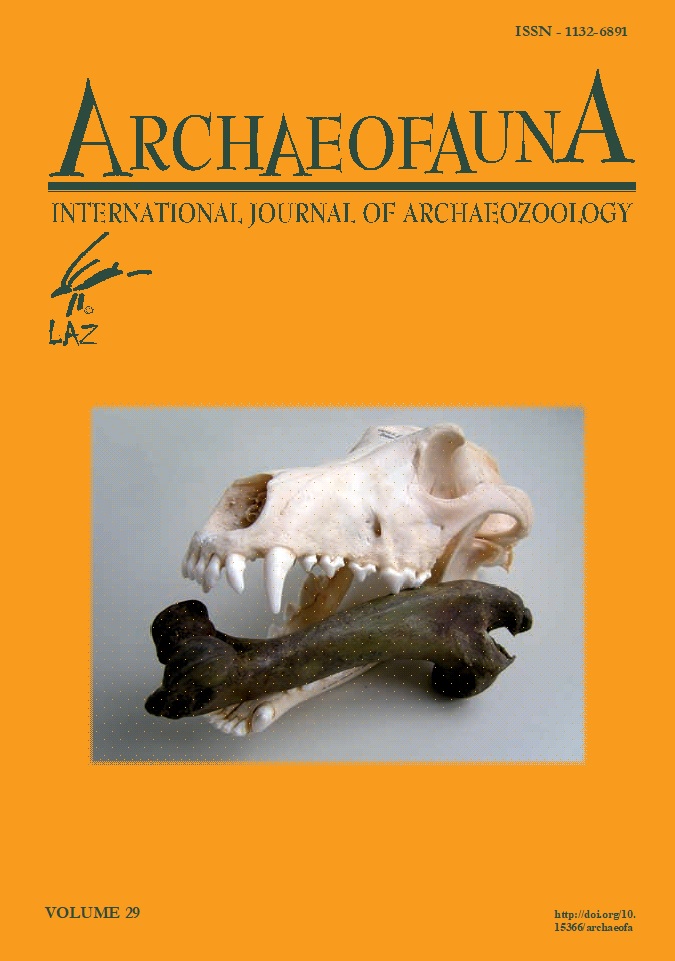Keywords:
ARCHAEOZOOLOGY, EGGSHELLS, RHEIDAE, PORES, SPECIES DETERMINATIONAbstract
From the end of the Pleistocene and up until the late Holocene, bones and abun- dant eggshell fragments testify to the hunting by the indigenous people of Rheidae in the Pampas and Chaco regions (greater rhea, Rhea americana), and in the Argentinian Patagonia (lesser/ Darwin´s rhea, R.pennata). The traditional method to set apart eggshell fragments from these two species consisted in counting the number pores on a given area to estimate their density. In this paper we evaluate the validity of this method with a new protocol to facilitate counting and assess its reliability on a large eggshell sample. As has been repeatedly proved, the greater rhea has a larger pore density than the lesser rhea. However, the variability of this density within each species, and even within the same egg, needs to be considered as this may lead to erroneous identification. More so when the number of pores per cm2 falls in the lowest range of the greater rhea or the highest range of the lesser rhea. In general, it is easier to misidentify a greater rheaeggshell fragment for that of the lesser rhea than the other way around. The possibility of misidentification also depends on the area of the shell that is being analyzed, since the original method did not apparently assess the density of pores in different areas of the same egg for each species. Although our results indicate that identification based on the original method is not as reliable as the one we propose here, a reappraisal of it with larger samples deriving from a larger specter of populations from both species would be recommendable.
Downloads
References
ALONSO ROLDÁN, V.; NAVARRO, J.LL.; GARDENAL, C.N. & MARTELLA, M.B. 2010: May captive populations of Greater rhea (Rhea americana) act as genetic reservoirs in Argentina? Zoo Biology 30: 6570. https://doi.org/10.1002/zoo.20314
APOLINAIRE, E. & TURNES, L. 2010: Diferenciación específica de Reidos a partir de fragmentos de cáscaras de huevos. Su aplicación en sitios arqueológicos del Holoceno Tardío. In: Berón, M.; Luna, L.; Bonomo, M.; Montalvo, C.; Aranda, C. & Carrera Aizpitarte, M. (eds.): Mamül Mapu: pasado y presente desde la Arqueología Pampeana: 215-222. Tomo 1. Libros del Espinillo. Ayacucho, Buenos Aires.
BATES, D.; MAECHLER, M.; BOLKER, B. & WALKER, S. 2015: Fitting Linear Mixed-Effects Models Using lme4. Journal of Statistical Software 67(1): 1-48. doi:10.18637/jss.v067.i01. https://doi.org/10.18637/jss.v067.i01
BIRDLIFE INTERNATIONAL 2016: Rhea americana. The IUCN Red List of Threatened Species 2016:e.T22678073A92754472. http:// dx.doi.org/ 10.2305/ IUCN.UK.2016-3.RLTS. T22678073A92754472.en. Downloaded on 24 September 2019.
BIRDLIFE INTERNATIONAL 2018: Rhea pennata. The IUCN Red List of Threatened Species 2018:e.T22728199A132179491. http://dx.doi.org/10.2305/IUCN.UK.2018-2.RLTS. T22728199A132179491.en. Downloaded on 24 September 2019.
BOARD, R.G.; TULLETT, S.G. & PERROTT, H.R. 1977: An arbitrary classification of the pore systems in avian eggshells. Journal of Zoology 182: 251-265. https://doi.org/10.1111/j.1469-7998.1977.tb04158.x
BONOMO, M.; LEÓN, D.; TURNES, L. & APOLINAIRE, E. 2008: Nuevas investigaciones sobre la ocupación prehispánica de la costa pampeana en el Holoceno tardío: el sitio arqueológico Claromecó 1 (Partido de Tres Arroyos, provincia de Buenos Aires). Intersecciones en Antropología 9: 25-41.
CARACOTCHE, M.; MUÑOZ, A.; CAÑETE MASTRÁNGELO, D. & LOBBIA, P. 2017: Yegua quemada 3: un depósito arqueológico del Holoceno Medio en el Parque Nacional Monte León (Patagonia, Argentina). Magallania (Chile) 45(2): 165-180. https://doi.org/10.4067/S0718-22442017000200165
GRELLET-TINNER, G. 2006: Phylogenetic interpretation of eggs and eggshells: implications for phylogeny of Palaeognathae. Alcheringa 30: 141-182. https://doi.org/10.1080/03115510608619350
HANDFORD, P. & MARES, M. 1982: La distribución de las especies de Rheidae (Aves, Rheiformes). Neotropica 28: 47-50.
KOYAMA, T. & TENNYSON, A. 2016: Respiratory Pores on Ostrich Struthio camelus (Aves: Struthionidae) Eggshells. In: Luo, Q.; Li, L.; Harrison, D.; Shi, H. & Bruley, D. (eds.): Oxygen Transport to Tissue XXXVIII. Advances in Experimental Medicine and Biology 923: 51-55. Springer, Cham. https://doi.org/10.1007/978-3-319-38810-6_7
MANGE, E.; DI LORENZO, M. & GONZÁLEZ VENANZI, L. 2018: Los restos faunísticos del sitio arqueológico Tembrao (provincia de Río Negro, Argentina). Revista del Museo de Antropología 11(1): 25-34. https://doi.org/10.31048/1852.4826.v11.n1.17257
MEDINA, M.; PASTOR, S.; APOLINAIRE, E. & TURNES, L. 2011a: Late Holocene subsistence and social integration in Sierras of Córdoba (Argentina): the South-American ostrich eggshells evidence. Journal of Archaeological Science 38: 2071-2078. https://doi.org/10.1016/j.jas.2011.05.001
MEDINA, M.; ACOSTA HOSPITALECHE, C.; TURNES, L.; APOLINAIRE, E. & PASTOR, S. 2011b: Huevos de Rhea pennata en el Holoceno Tardío de la provincia de Córdoba (Argentina): implicaciones ambientales, zoogeográficas y arqueológicas. Archaeofauna 20: 157-169.
R CORE TEAM 2017: R: A language and environment for statistical computing. R Foundation for Statistical Computing, Vienna, Austria. URL https://www.R-project.org/. (ver. 3.4.1, downloaded on 30 June 2017).
TAMBUSSI, C. & ACOSTA HOSPITALECHE, C. 2002: Rheidos (Aves) Cuaternarios de Argentina: influencias paleoambientales. Ameghiniana (Revista de la Asociación Paleontológica Argentina) 39(1): 95-102.
TULLETT, S. 1978: Pore size versus pore number in avian eggshells. In: Riiper, J. (ed.): Respiratory Function in Birds, Adult and Embryonic: 217-226. Springer, Berlin. https://doi.org/10.1007/978-3-642-66894-4_30
TULLETT, S. & BOARD, R. 1977: Determinants of avian eggshell porosity. Journal of Zoology 183: 203211.
TYLER, C. 1953: Studies on egg shells. II. A method for marking and counting pores. Journal of Science of Food and Agriculture 4: 266-272. https://doi.org/10.1002/jsfa.2740040603
TYLER, C. & GEAKE, F. 1953: Studies on egg shells. I. The Determination of Membrane-, Poreand Matrix-Protein. Journal of Science of Food and Agriculture 4: 261-266. https://doi.org/10.1002/jsfa.2740040602
TYLER, C. & SIMKISS, K. 1959: A study of egg shells of Ratite Birds. Proceedings of the Zoological Society of London 133: 201-243. https://doi.org/10.1111/j.1469-7998.1959.tb05561.x

